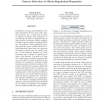119 search results - page 19 / 24 » Sparse kernel methods for high-dimensional survival data |
BMCBI
2010
13 years 9 months ago
2010
Background: Recent advances in proteomics technologies such as SELDI-TOF mass spectrometry has shown promise in the detection of early stage cancers. However, dimensionality reduc...
UAI
2008
13 years 11 months ago
2008
Identifying co-varying causal elements in very high dimensional feature space with internal structures, e.g., a space with as many as millions of linearly ordered features, as one...
MICCAI
2005
Springer
14 years 10 months ago
2005
Springer
Functional Magnetic Resonance Imaging(fMRI) has enabled scientists to look into the active human brain, leading to a flood of new data, thus encouraging the development of new data...
ICML
2005
IEEE
14 years 10 months ago
2005
IEEE
The Relevance Vector Machine (RVM) is a sparse approximate Bayesian kernel method. It provides full predictive distributions for test cases. However, the predictive uncertainties ...
NIPS
1998
13 years 11 months ago
1998
A common way to represent a time series is to divide it into shortduration blocks, each of which is then represented by a set of basis functions. A limitation of this approach, ho...

